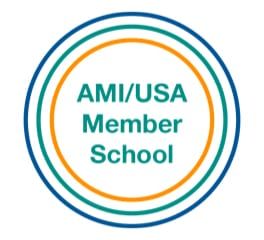Classroom Notes | April 2019
Ms. Hunt:
“Spring is here,” said the bumble bee!
We are soaking up the spring sunshine by working in our outside environment, and observing the signs of warmer weather. Stump hammering, window washing, stone scrubbing and rock painting are some of the activities set up outside, and the children are able to freely move in and out of the classroom, choosing these activities the same way that they do inside. Children may also move a work table or rug outside and bring their work from a shelf in the classroom. Free flow to the outside environment is a hallmark of Montessori education, and we are fortunate to have it in our classroom. It allows children to truly connect to the world around them, work joyfully, and make discoveries and observations about nature.
We are also enjoying the picnic table that was made and donated by the Farasyn family…Thank you!!!
The children are learning about the different parts of flowers, plants and seeds, and we have begun sprouting seeds for our garden! Some seeds have been started inside in seeds trays, while some are sown directly into the ground. The children love to watch the progress that seedlings make, and are invited to water the seedlings and garden beds each day. We will tend to the growing plants for the remainder of the year and over the summer so that the garden’s growth will be a gift to the children in the next academic year.
The children are able to observe the process of metamorphosis first hand by watching our painted lady caterpillars. Currently, our caterpillars have turned into chrysalis’ and we are eagerly awaiting their transformation into butterflies! The children have been so excited to witness the life cycle of a butterfly, to learn more about this amazing process in nature, and to take respectful care of the butterfly habitat.
Some songs and poems we have learned this month are: “Treehouse” by Shel Silverstein, “Butterfly”, “Dandelion Song”, “Robin in a Pine Tree”, “April Showers”, and “White Choral Bells”.
Thank you to all the parents for a wonderful round of Spring conferences…it is always refreshing to meet face to face to discuss the Montessori Method and the journey of your child. I value your observations and anecdotes, and am appreciative to be part of such a curious, open minded and supportive community! Happy spring!
Ms. Thome
Spring is always a wonderful time of year to help children feel connected with nature and to instill in them an appreciation for the amazing world in which we live! We have been learning the importance of respecting all living creatures and the children have been taking that role very seriously. We have some very keen ‘bug rescuers’ and if they see a bug in a puddle or a worm out of the dirt, they quickly find a safe spot for it! The children are not only growing in inches, but are developing into wonderful members of our FCMS community!
We have been loving the miraculous transformation of our caterpillars! We have been studying the life cycle a butterfly with wonderful tid-bits of butterfly facts along the way. For example , did you know that butterflies can taste flowers with their feet??
Spring Songs:
- Robin in the Rain
- Spring is Here
- April Showers
What a pleasure it is for us to slow down our own lives and match the child’s speed, share the cooking, the making of gifts, baking, sewing and knitting, gardening, making cards, laundry, fixing and oiling furniture, arranging flowers, building and cleaning, and so forth. Life becomes richer and more loving. The most important gift we can give our children is our time.
It has been such a pleasure getting to know all of your wonderful children. It will be bittersweet to see the year end. Thank you all so much for your words of gratitude and all of your contributions with the classroom needs!
We look forward to another busy month ahead! Many thanks for your continued support, we are truly blessed to have such a wonderful group of children and such a supportive community!
Ms. Crews
Springtime in Our Community
We have welcomed spring by transitioning our classroom work and our lunchtime outdoors!
It is such a gift for children to take in the sensory experiences of the breeze and sunshine while they work or enjoy a meal. From our outdoor classroom, we can hear the large cottonwood tree rustling and observe ants, squirrels, birds, and occasionally geese or deer who visit. It also sends the message that the expectations we hold in our community don’t disappear when we step outside. This challenges the conventional “recess” model we see in traditional school environments where restricted movement gives way to chaos. Being outdoors, on the contrary, is a time to respectfully observe and care for living things around us just as we do inside of our classroom.
Springtime Poetry
In addition to singing songs, our community is loving reciting poems
about springtime! We recite
these out loud while we are in a gathering or waiting in a line. Here is one that has made us all feel particularly joyful lately:
Mudlarks
by Shirley Hughes
I like mud.
The slippy, sloppy, squelchy kind,
The slap-it-into-pies kind.
Stir it up in puddles, slither and slide.
I
do
like mud.
Spring Plants
This month, we started seeds indoors and out. The children have watched kale, rainbow chard, zinnias, and sunflowers sprout and grow as they water them each day. We also have fragrant culinary herbs (lavender, rosemary, and chives) that we can taste and smell!
Caterpillars to Butterflies
This month, we had some Painted Lady caterpillars join our community. We have been observing them on the shelf as they go through their life cycle.
In just a couple of weeks, they have nearly tripled in size! We will watch as they each build a chrysalis and then emerge as butterflies. This has been a lovely way for the children witness a natural process from start to finish that we don’t often see firsthand.
Music
Appreciation
Each day, twice a day, we “take care” of our classroom by moving around the room and helping refresh things with our hands: we re-roll rugs, we pick up trash, we straighten materials on the shelves, etc. Care of the environment happens continually throughout the day, but these are communal, joyful times we all work together to prepare the environment for the next part of the day.
While we tidy up, we listen to music. The CD we are currently enjoying is “World Playground” by Putumayo Kids . Our agreements during this time are that we keep our voices silent so that everyone can hear the music, and that although we are welcome to move our bodies to the rhythm, everyone’s hands are helping.
Music appreciation is a lovely way to share your interests with your children at home. Children can enjoy a wide variety of music (as long as the lyrics are appropriate) that needn’t be “kid’s music;” adults should enjoy listening to it too!
In the same way that we give children things that are real and beautiful to use with their hands, we can give them the gift of real, beautiful music.
Ms. Jennings and I have continued gratitude for all of the parent donations through laundry, classroom materials, flowers, lemons, and more! We couldn’t do it without you. Thank you all for another lovely month!
Ms. Schiller
Gardening/Plants
BY MIRIAM, JULIA and KATIA
In our classroom we have many plants. One of them is called the setcreasea pallida/purple heart. When you put water on its leaves the water rolls off and the leaves aren’t wet. This plant has a special way for you to care for it. You care for the plant by putting it in a place that either has bright light or a medium amount of light. You also need to water it around once a week. Make sure that it is not over watered.
We also have learned from our assistant teacher, Ms. Jones. She is teaching us to plant things. Last year we donated some vegetables that we grew to the Food Bank. This year we are putting dirt into empty egg cartons. Then we bury a bean seed and put dirt on top of that. Then we put in a popsicle stick with our name on it. When the beans sprout we will plant the seedlings outside.
End Of The Year Activities
BY MIRIAM, JULIA and KATIA
For the last day of school we will have a lemonade and iced tea stand, a bake sale, and a raffle. We have jobs for people in our class that want to help with the last day of school picnic. Children will make prizes for the raffle. Another job for the raffle is that there will be people to take the money. It will be one dollar to enter.
Here are the jobs for the lemonade and iced tea stand: lemonade and iced tea makers, cashiers, refillers and carriers. These are the jobs for the bake sale: handers to hand the food, cashiers, bakers and carriers. We are so exited for the last day of school and the moving up ceremony!!!!!!!!
P.E.
BY GRAHAM
We have P.E. every Friday. Sometimes we need a substitute P.E. teacher. In P.E. we learn lots of new sports such as: soccer, baseball, volleyball, kickball, softball, lacrosse, basketball and track. P.E. stands for physical education.
Some people, like me, don’t like P.E., but other people love it. If you are wondering why I don’t like P.E. it is because I think P.E. is very competitive. Bye bye!
Our Recent Trip to Red Fox Meadows
Ms. Arminio
As our school year comes to an end, it seems that our work and projects never end!
- We received our published short story books and we are planning our reading and book signing event.
- The third year students are in production, creating and practicing a version of Charlie and the Chocolate Factory.
- If the weather permits, we will take nature walks in Red Fox Meadows.
- Our garden is planted and we are working on a special springtime garden treat for our families.
- Hopefully, we will watch the metamorphosis in our butterfly farm and afterwards, we will have our annual butterfly release celebration. Love is like a butterfly: It goes where it pleases and it pleases wherever it goes. ~Author Unknown.
Yes, indeed, a busy season of the year
SOMETHING TO LOOK FORWARD TO FOR THIRD YEAR STUDENTS
Fort Collins Water Festival – May 22, 2019
Each spring, approximately 1,800 third-grade students and teachers from public, private and home schools attend the festival which is sponsored by Fort Collins Utilities and Northern Colorado Water Conservancy District (NCWCD). The festival is packed with fun, hands-on activities that teach students about water. Students spend half a day attending classroom presentations and visiting many displays in the exhibit hall. The Fort Collins Children’s Water Festival is the longest-running festival in the state. Emphasis is placed on hands-on, age-appropriate activities, including learning about:
- Wetlands and rivers
- Aquatic insects and wildlife
- Water resources
- Supply and conservation
- Water quality and safety
- Agricultural uses
- Water chemistry
- Water and wastewater treatment
- Drought and flooding
- Importance of water in the human body
For more information about the festival, contact [email protected].
VISITORS AND BIG WORK
This week we welcomed our primary transition students and indulged them in the elementary big sprawling work. Activities that appealed to them included a shapes, polygons chart labelled and painted; a study of an artist and the creation of a gallery poster, labelled with titles; a pictures poster of nouns, or nouns with adjectives, colored with word labels; a story poster using pictures for sequencing and a discussion for comprehension; a chart of the individual states of the USA, labelled and designating capital cities; a poem, recited and written in big cursive with an illustration.
For great (big) summer projects, think large white paper from a roll, smaller papers, colored paper, pencils, colored pencils, paint, tracing, cutting and gluing. Lower elementary ages love all of the above and can/will create for hours.
Mr. Deery
A Interview with Dr. Caleb Schoonover
BY ETHAN
Dr. Caleb Schoonover completed his Optometry Degree at the Northeastern State University of Oklahoma College of Optometry. Dr. Caleb owns and runs Rocky Mountain Family Vision.
What are the pros & cons of your job?
He likes helping others see but he hates telling people that they might lose their sight.
How many eyes have you dissected?
He has dissected 10 eyes.
How many years of school did it take you to learn to be an optometrist?
8 years of school.
What eye problems have you treated most often?
Sty, Chalazion, Cataract, and Sclera.
What age patients have you had most often?
Infants 4-6 months.
Why do you like being an optometrist?
It helps a lot of people.
When did you decide to be an optometrist?
At 21 years of age.
Interview with Jakin
BY ERYK
Today, I will be interviewing Jakin Mirabito, a fifth grader from Mr.Deery’s class. I will be interviewing him about the cow’s eye dissection he, Caleb, and Saigen performed.
Q. What did you think of the dissection?
A. Very fascinating because we learned a lot more about the eye. I found it surprising that the retina was so fragile. It looked like ham but more colorful. I also found the blind spot really cool. I didn’t think there would be that much tissue surrounding the eye. I also didn’t expect the vitreous or the back of the eye to be so colorful.
Q. What was your favorite part?
A. Touching the the different parts of the eye because all the parts were really tough.
Q. What was your least favorite part?
A. My least favorite part was not getting to dissect more eyes.
Q. Were you grossed out?
A. No, I wasn’t grossed out and very few people were.
Q. How long did it take you to do the research?
A. We aren’t finished and we have been doing it since December 2018. We have 2 pages to finish.
Q. Are eyes difficult to dissect?
A. Some what, but not really that hard. You had to be very careful not to cut the wrong parts like when we were cutting the tissue of the eye.
Q. What did it smell like?
A. There was not much of a smell.
Q. How long did it take?
A. 20-40 minutes
The Dissection of an Eye
BY EMILIO
Recently, a local optometrist, Dr Caleb, visited our classroom to teach us how to dissect a cow’s eye. After he introduced himself to the class, he took out the cow’s eye and everyone said, “Wow” or “Gross.” I thought it looked cool. Then Dr.Caleb cut off the tissue that was made up of fat and muscle. After that, he cut the eye in half and showed us the front part of the eye. He cut off the cornea which is what enables light rays to enter the eye. We then saw a jelly stuff called vitreous.
After that, he went to the back part of the eye and showed us something called the retina.The retina is what captures the image in your eye. Then he showed the Tapetum Lucidum, which is what helps animals see in the dark so predators don’t eat them.
Dr. Caleb left us with a better understanding of the eye.
The post Classroom Notes | April 2019 appeared first on Fort Collins Montessori School.
Education That Nurtures The Human Potential
QUICK LINKS
Fort Collins Montessori School















